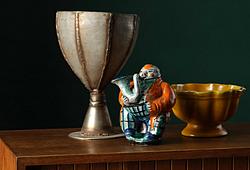Arman (Armand Pierre Fernandez)
"Pieces of Liberty"
Signed Arman, numbered AP 1/2. Edition 3 + 2 AP. Executed 1985. Height 67 cm. Green patinated bronze, height 67 cm. This work is recorded in the Arman Studio Archives New York under number: APA# 8306.85.007
Provenance
AH Grafik, Stockholm, Sweden.
More information
Fernandez Arman's interpretations and adaptations of the legendary Statue of Liberty is a recurring theme in Arman's long artistry.
Throughout his career, Arman has worked with varying techniques for "accumulations" and "deconstructions”.
Works of art that he either crushed, sliced or burned. These objects tended to be musical instruments, sculptural reproductions and even furniture. He began creating his "deconstructions" in 1959 with his Violins, fragile wooden instruments that he dissected in various ways. The motive behind his artistic actions is to interrupt the deconstruction and control the final stages of an object's life.
His object-oriented approach looks back at Marcel Duchamp's art. Yet, Arman differentiates himself by saying “as I evolved into object art, I found myself being called a Pop-Artist, but the term isn’t exactly right. Pop-Artists changes and processes the object. I used the real object. Marcel Duchamp, who is the obvious ancestor of object art, might have taken a soup can and put it on a pedestal. Andy Warhol would repaint the soup can. Jasper Johns would cast it in bronze. I’d take the soup can and cut it into pieces or weld hundreds of them together in order to change the state of the object from what it was when you first saw it in the supermarket. My interest is in exploring the various worlds of the object."
Arman's unique view and contemplation of the Statue of Liberty as an object, attracts the eye to explore its many layers and the different perspectives that emerge in the interpretation. Each part of the original statue is divided and displaced, but retains its original shape despite ongoing deconstruction. On her head sits her famous gold crown. The torch in her right hand is also colored a brilliant golden luster. Through the sculpture's richness of detail, viewers can still distinguish the intricate folds of her clothes and the details of her costume. Her revelation is subtly discernible, which encourages further contemplation and thought.
Artist
Arman (Pierre Fernandez, born in Nice in 1928) moved to Paris after graduation to study archaeology and oriental art. After returning to Nice in 1953, he devoted himself instead to abstract art and began collaborating with Yves Klein, which was to have a significant impact on his artistic development. After a typographical error in an exhibition catalogue at the legendary Galerie Iris Clert in Paris, in which the letter "d" had dropped from his name, Arman decided that henceforth he would sign his works only "Arman".
In the late 1950s, he began working with sculptures, first the series Accumulations with everyday objects and then Poubelles consisting of rubbish.
In 1960, Arman co-founded the Nouveau Réalisme group with Jean Tinguely and Daniel Spoerri, among others. Later César, Niki de Saint Phalle and Christo joined. The group opposed informal art and became the French equivalent of English and American pop art.
During the 1960s, Arman travelled to New York for the first time, where he exhibited at the Cordier-Warren Gallery and MoMA. He continued to work with sculptures through different series such as 'Coupes' (sawed and sliced objects), 'Colères' (disintegrated and broken objects), 'Combustions' (burnt objects) and 'Inclusioni' (assemblage of objects enclosed in polyester resin).
Arman's work was shown both at the Stedelijk Museum, Amsterdam (1964) and at the Venice Biennale (1968) in the following years. In the 1970s, he created assemblages with cement and car parts in collaboration with Renault. In 1973 he became an American citizen when he moved to New York.
During the last twenty years of his life, Arman continued to work with different materials and techniques. He has executed several monumental works such as the bronze work "A la République" (1984) in the Palais de l'Élysée, Paris and the work "Espoir de Paix" (1995) in Beirut, an assemblage of cement and tanks. It is still the world's largest sculpture.
Arman died in 2005 in New York. During his lifetime, he participated in almost 500 solo exhibitions. His works are today included in collections at MoMA, NY, The National Gallery of Art, Washington, Tate Modern, London and Musée d'Art Moderne et d'Art Contemporain, Nice.
Read more
















































